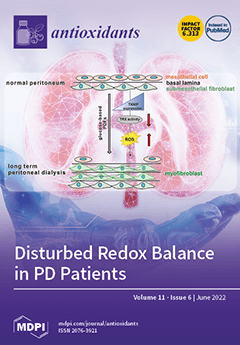Purpose: To compare the results of surgical treatment and changes in biomarkers of cholestasis, endotoxicosis, cytolysis, lipid peroxidation, glycolysis disorders, and inflammation in patients with benign and malignant obstructive jaundice (OJ) in patients receiving and not receiving antioxidant pharmacotherapy (AOT). Patients and methods:
[...] Read more.
Purpose: To compare the results of surgical treatment and changes in biomarkers of cholestasis, endotoxicosis, cytolysis, lipid peroxidation, glycolysis disorders, and inflammation in patients with benign and malignant obstructive jaundice (OJ) in patients receiving and not receiving antioxidant pharmacotherapy (AOT). Patients and methods: The study included 113 patients (aged 21–90 years; 47 males and 66 females) who received surgical intervention for OJ due to non-malignant (71%) or malignant tumor (29%) etiologies. Patients were divided into two groups: Group I (
n = 61) who did not receive AOT and Group II (
n = 51) who received AOT (succinate-containing drug Reamberin) as part of detoxification infusion therapy. The surgical approach and scope of interventions in both groups were identical. Dynamic indicators of endotoxicosis, cholestasis, and cytolysis (total, direct, and indirect bilirubin, alanine aminotransferase [ALT], aspartate aminotransferase [AST], alkaline phosphatase [AP] and gamma-glutamyltransferase [GGT]), kidney function (urea), lipid peroxidation (malonic dialdehyde, MDA), inflammation (leukocytosis), and glycolysis disorders (lactate dehydrogenase (LDH), glucose) were evaluated. Results: Tumor jaundice, unlike non-tumor jaundice, persisted and was characterized by a more severe course, a higher level of hyperbilirubinemia, and lipid peroxidation. The prognostic value of the direct (and total) bilirubin, MDA, glycemia, and leukocytosis levels on the day of hospitalization, which increased significantly in severe jaundice and, especially, in deceased patients, was established. Decompression interventions significantly reduced levels of markers of liver failure, cytolysis, cholestasis, and lipid peroxidation on day 3 after decompression by 1.5–3 times from initial levels; this is better achieved in non-tumor OJ. However, 8 days after decompression, most patients did not normalize the parameters studied in both groups. AOT favorably influenced the dynamics (on day 8 after decompression) of total and direct bilirubin, ALT, AST, MDA, and leukocytosis in non-tumor jaundice, as well as the dynamics of direct bilirubin, AST, MDA, glucose, and LDH in tumor jaundice. Clinically, in the AOT group, a two-fold reduction in the operative and non-operative complications was recorded (from 23% to 11.5%), a reduction in the duration of biliary drainage by 30%, the length of stay in intensive care units was reduced by 5 days, and even hospital mortality decreased, especially in malignancy-induced OJ. Conclusion: A mechanism for the development of liver failure in OJ is oxidative stress with the appearance of enhanced lipid peroxidation and accompanied by hepatocyte necrosis. Inclusion of AOT in perioperative treatment in these patients improves treatment outcomes.
Full article






